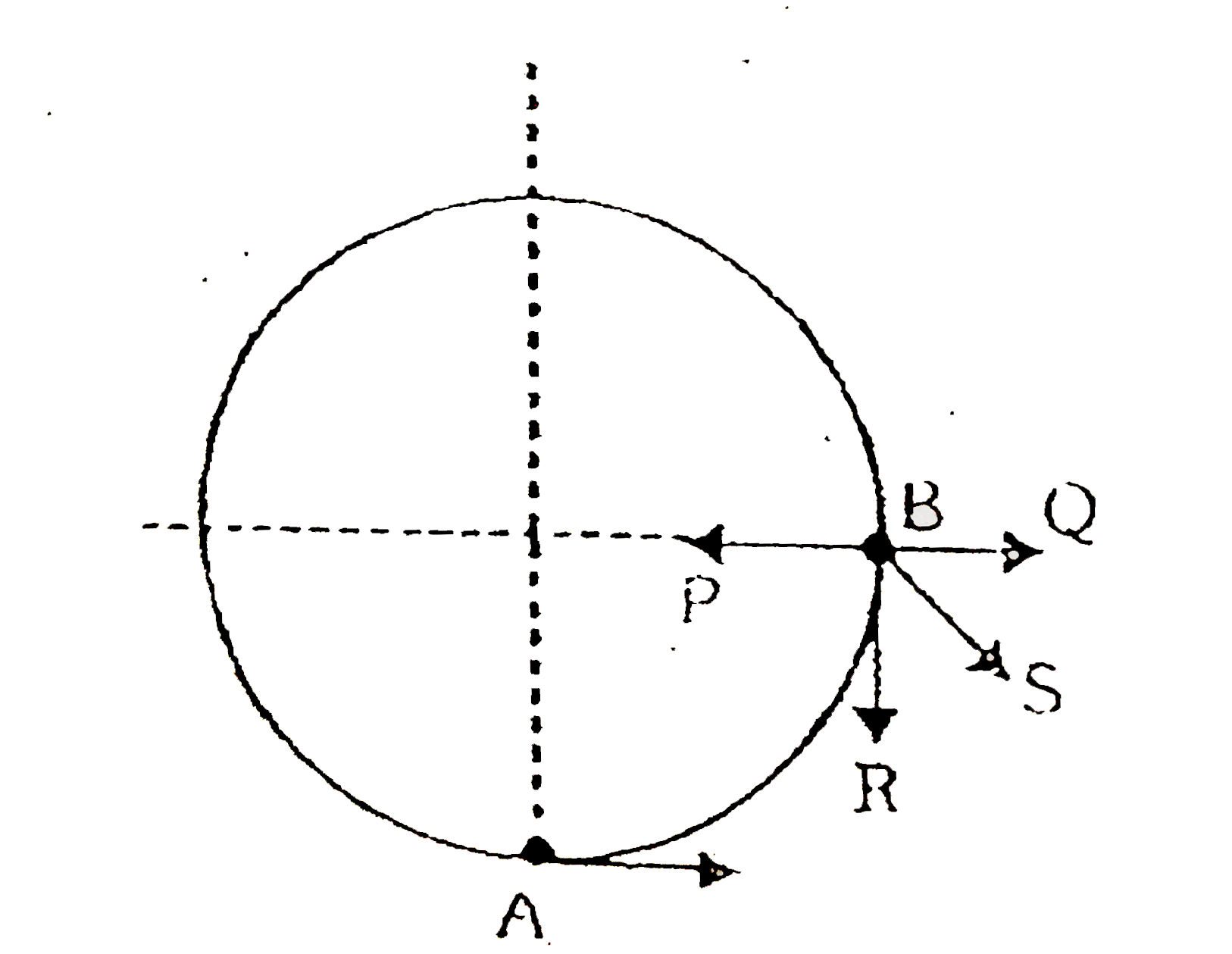Two copper balls of radius r and 2r are released at rest in a long tube filled with liquid of uniform viscosity. After some time when both the spheres acquire critical velocity (terminal velocity) then ratio of viscous force on the balls is :
1:2
1:4
1:8
1:18
To solve the problem, we need to find the ratio of the viscous forces acting on two copper balls of different radii when they reach terminal velocity in a viscous liquid.
1. Identify the Forces Acting on the Balls:
Each ball experiences three forces:
- The gravitational force (Fg) acting downwards.
- The buoyant force (Fb) acting upwards.
- The viscous force (Fv) acting upwards when the ball is moving through the liquid.
At terminal velocity, these forces balance out:
Fg−Fb=Fv
2. Calculate the Gravitational Force:
The gravitational force on a sphere is given by:
Fg=V⋅ρm⋅g
where V is the volume of the sphere, ρm is the density of the sphere, and g is the acceleration due to gravity.
The volume V of a sphere is given by:
V=43πr3
For the first ball (radius r):
Fg1=43πr3⋅ρm⋅g
For the second ball (radius 2r):
Fg2=43π(2r)3⋅ρm⋅g=43π(8r3)⋅ρm⋅g=323πr3⋅ρm⋅g
3. Calculate the Buoyant Force:
The buoyant force is given by:
Fb=V⋅ρl⋅g
where ρl is the density of the liquid.
For the first ball:
Fb1=43πr3⋅ρl⋅g
For the second ball:
Fb2=43π(2r)3⋅ρl⋅g=323πr3⋅ρl⋅g
4. Calculate the Viscous Force:
The viscous force can be calculated using the balance of forces at terminal velocity:
Fv=Fg−Fb
For the first ball:
Fv1=Fg1−Fb1=(43πr3⋅ρm⋅g)−(43πr3⋅ρl⋅g)=43πr3g(ρm−ρl)
For the second ball:
Fv2=Fg2−Fb2=(323πr3⋅ρm⋅g)−(323πr3⋅ρl⋅g)=323πr3g(ρm−ρl)
5. Find the Ratio of Viscous Forces:
Now, we can find the ratio of the viscous forces:
Fv1Fv2=43πr3g(ρm−ρl)323πr3g(ρm−ρl)=432=18
Final Answer:
The ratio of the viscous forces on the balls is:
Fv1Fv2=1:8
Each ball experiences three forces:
- The gravitational force (Fg) acting downwards.
- The buoyant force (Fb) acting upwards.
- The viscous force (Fv) acting upwards when the ball is moving through the liquid.
Fg−Fb=Fv
The gravitational force on a sphere is given by:
Fg=V⋅ρm⋅g
where V is the volume of the sphere, ρm is the density of the sphere, and g is the acceleration due to gravity.
V=43πr3
For the first ball (radius r):
Fg1=43πr3⋅ρm⋅g
For the second ball (radius 2r):
Fg2=43π(2r)3⋅ρm⋅g=43π(8r3)⋅ρm⋅g=323πr3⋅ρm⋅g
The buoyant force is given by:
Fb=V⋅ρl⋅g
where ρl is the density of the liquid.
Fb1=43πr3⋅ρl⋅g
For the second ball:
Fb2=43π(2r)3⋅ρl⋅g=323πr3⋅ρl⋅g
The viscous force can be calculated using the balance of forces at terminal velocity:
Fv=Fg−Fb
For the first ball:
Fv1=Fg1−Fb1=(43πr3⋅ρm⋅g)−(43πr3⋅ρl⋅g)=43πr3g(ρm−ρl)
For the second ball:
Fv2=Fg2−Fb2=(323πr3⋅ρm⋅g)−(323πr3⋅ρl⋅g)=323πr3g(ρm−ρl)
Now, we can find the ratio of the viscous forces:
Fv1Fv2=43πr3g(ρm−ρl)323πr3g(ρm−ρl)=432=18
The ratio of the viscous forces on the balls is:
Fv1Fv2=1:8
Topper's Solved these Questions
Similar Questions
A small steel ball of radius r is allowed to fall under gravity through a column of a viscous liquid of coefficient of viscosity η. After some time the velocity of the ball attains a constant value known as terminal velocity υT. The terminal velocity depends on (i) the mass of the ball m (ii) η, (iii) r and (iv) acceleration due to gravity g . Which of the following relations is dimensionally correct?
View SolutionA small steel ball of radius r is allowed to fall under gravity through a column of a viscous liquid of coefficient of viscosity η. After some time the velocity of the ball attains a constant value known as terminal velocity υT. The terminal velocity depends on (i) the mass of the ball m (ii) η, (iii) r and (iv) acceleration due to gravity g . Which of the following relations is dimensionally correct?
View Solution
Knowledge Check
Two spheres of equal masses but radii R and 2 R are allowed to fall in a liquid, the ratio of their terminal velocities is
A1:4B1:2C1:32D2:1Spherical balls of radius R are falling in a viscous fluid of velocity v .The retarding viscous force acting on the spherical ball is
Adirectly proportional to R but inversely proportional v.Bdirectly proportional to both radius R and velocity v.Cinversely proportional to both radius R and velocity v.Dinversely proportional to R but directly proportional to velocity v.A metal ball B1 (density 3.2g/cc) is dropped in water, while another metal ball B2 (density 6.0g/cc) is dropped in a liquid of density 1.6g/cc. If both the balls have the same diameter and attain the same terminal velocity, the ratio of viscosity of water to that of the liquid is
A2B0.5C4Dindeterminate due to insufficient data
A small steel ball of radius r is allowed to fall under gravity through a column of a viscous liquid of coefficient of viscosity η. After some time the velocity of the ball attains a constant value known as terminal velocity υT. The terminal velocity depends on (i) the mass of the ball m (ii) η, (iii) r and (iv) acceleration due to gravity g . Which of the following relations is dimensionally correct?
View SolutionThe velocity of small ball of mass M and density (d1= when dropped a container filled with glycerine becomes constant after some time. If the density glycerine is d2, the viscous force acting on ball is
View SolutionA solid ball of density ρ1 and radius r falls vertically through a liquid of density ρ2. Assume that the viscous force acting on the ball is F=krv, where k is a constant and v its velocity. What is the terminal velocity of the ball ?
View SolutionA ball of mass m inside a smooth spherical shell of radius R with velocity √2qR at A What is the direction of force acting on the ball, when it reaches B ?

View SolutionA metal ball B1 (density 3.2g/cc) is dropped in water, while another metal ball B2 (density 6.0g/cc) is dropped in a liquid of density 1.6g/cc. If both the balls have the same diameter and attain the same terminal velocity, the ratio of viscosity of water to that of the liquid is
View Solution
